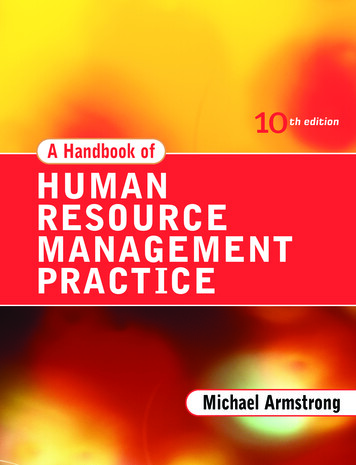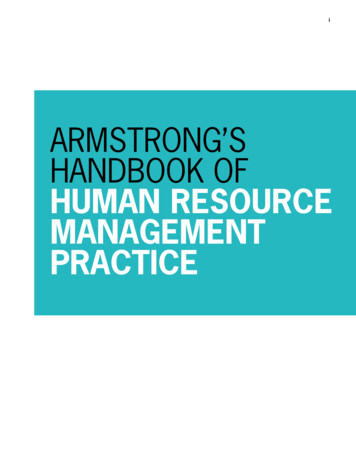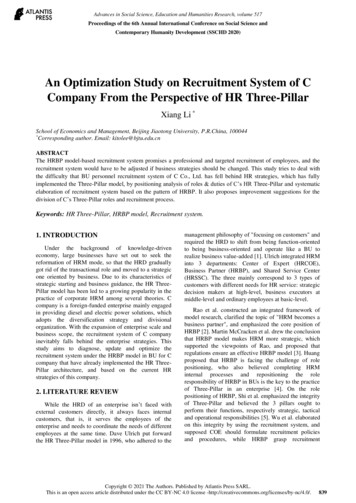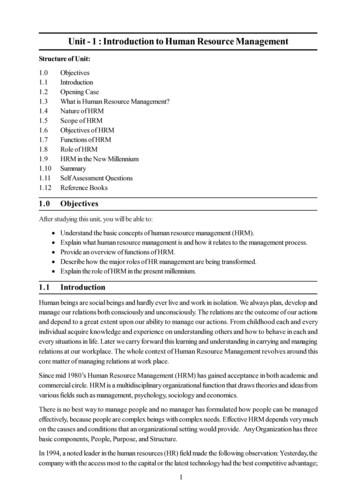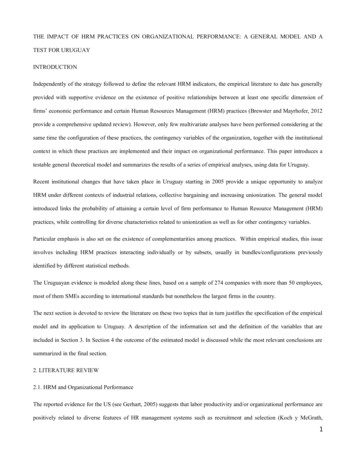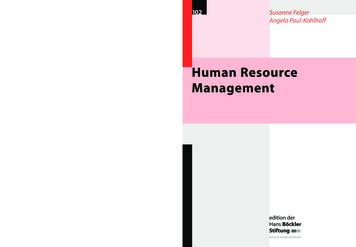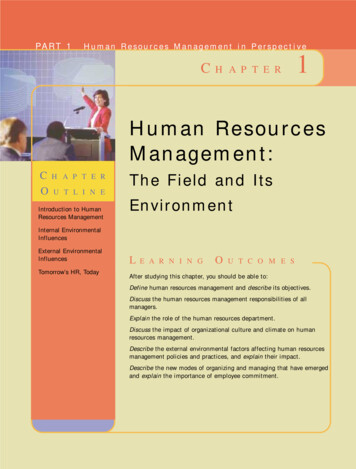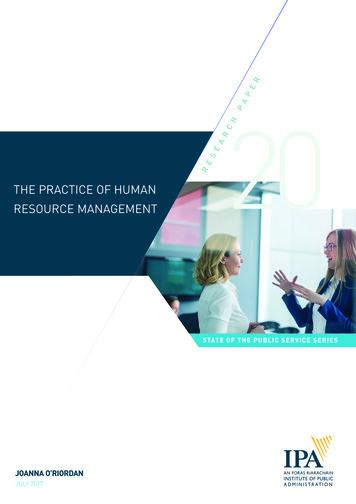
Transcription
HRM IV SEMBBMUNIT IINTORDUCTION OF HRMMEANING OF HRM HRM is the art of Procuring, developing and maintaining competent workforceto achieve organisational goals effectively. The process of employing people, developing their resources, utilising,maintaining & compensating their service in tune with the job & organisationalrequirements with a view to contribute to the goals of the organisation,individual & the society.DEFINITIONAccording to Wendell L French “ the human resource management refers to thephilosophy, policies, procedures, & practice related to the management of peoplewithin an organisation.According to Stephen P Robbins, HRM is a process consisting of the acquisition,development, motivation & maintenance of human resources.SCOPE OF HRMThe Scope of Human Resource management into the following aspects1. The Personnel AspectThis aspect of HRM is concerned with the manpower planning, recruitment,selection, placement, induction, transfer, promotion, demotion, termination,training & development, layoff & retrenchment, wage & salary administration,incentives, productivity etc.2. The Welfare Aspect:The welfare aspect is concerned with working conditions & amenities such ascanteens, crèches, rest rooms, lunch rooms, housing, transport, education,medical help, health & safety, washing facilities recreation & cultural activitiesetc.3. The Industrial Aspect:This aspect is concerned with employees. It includes union managementrelations, joint consultation, negotiating collective bargaining, grievancehandling, disciplinary actions, settlement of industrial disputes etc.SANGEETHA . NASST. PROF.Page 1SSCASC,TUMKURU.
HRM IV SEMBBMIMPORTANCE OF HRM1. Importance for the Organisation:HRM is important for the organisation to the following: Good human resource practices help in attracting & retaining the bestpeople in the organisation. In order to make use of latest technology the appointment of right typeof persons is essential. The right people can be fitted into new jobsproperly only if the management performs its HR function satisfactorily. Globalisation has increased the size of the organisation who employthousands of employees in different countries. The performance of thecompany depends upon the qualities of the people employed. This hasfurther increased the importance of HRM HR planning alerts the organisation to the types of people it will need inthe short , medium & long run. HR development is essential for meeting the challenges of future. Theimportance of HRM has increased because of the shortage of reallymanagerial talent in the country.2. Importance for the employees HRM stress on the motivation of employees by providing them variousfinancial & non-financial incentives. Right organisational climate is also stressed upon so that the employees cancontribute their maximum to the achievement of the organisational objectives. Effective management of HR promotes team wok & team spirit amongemployees. It offers excellent growth opportunities to people who have the potential to rise. It also encourages people to work with diligence & commitment.3. Importance for the society:Good HR efforts lead to productivity gains (ration of output to input) to thesociety, since it enables the managers to reduce costs, save scarce resources,enhance profits & offer better pay, benefits & working conditions to employees.SANGEETHA . NASST. PROF.Page 2SSCASC,TUMKURU.
HRM IV SEMBBMOBJECTIVES OF HRM1) Societal Objectives : To manage human resources in an ethical & socially responsiblemanner. To ensure compliance with legal & ethical standards. To minimise the negative impact of societal demands upon theorganisation.2) Organisational Objective: HR department, like any other department in an organisation, shouldfocus on achieving the goals of the organisation first. If it does not meetthis purpose, the HR department cannot exist in the long run. HR department should recognise its role in bringing aboutorganisational effectiveness. HRM is not an end in itself. It is only a means to assist the organisationwith its primary objectives.3) Functional Objectives: To maintain the HRM departments contribution at a level appropriate tothe organisation’s needs. Resources are wasted when HRM is eithermore or less sophisticated to suit the organisation’s demands. The department’s level of service must be tailored to fit the organisationit serves. HRM should employ the skills & abilities of the workforce efficiently.It should aim at making the people’s strength more productive &beneficial to the organisation. HRM should aim at providing the organisation with well trained & wellmotivated employees.4) Personnel Objectives HRM should increase employees job satisfaction to the fullest extent. HRM should also meet the self actualisation needs of the employees. Itshould stimulate every employee to achieve his potential. HRM should assist the employees in achieving their personal goals, atleast in so far as these goals enhance the individual’s contribution to theorganisation. HRM should develop & maintain a quality of work life. It makesemployment in the organisation a desirable, personal & social situation.Organisational performance can never be improved without the qualityof work life.SANGEETHA . NASST. PROF.Page 3SSCASC,TUMKURU.
HRM IV SEMBBM The HRM should also communicate HR policies to all employees. Itwill help the HRM in tapping the ideas, opinions, feelings, & the viewsof the employees.PERSONNEL MANAGEMENTMeaning:- it is the process of Planning, organising, compensation, integration &maintenance o people for the purpose of contributing to organisational individual &societal goals.Personnel management can be defined as obtaining, using & maintaining a satisfiedworkforce.Definition:- Acc. to Flippo “ personnel management is the planning, organizing,compensation, integration & maintenance of people for the purpose of contributing toorganisational, individual & societal goals.Acc, to Brech “ personnel management is that part which is primarily concerned withhuman resources of organisation.DIFFERENCES BETWEEN PERSONNEL MANAGEMENT & HRMPERSONNEL MANAGEMENTIt is a traditional approach to managingpeople in the organisation.It focuses on personnel administration,employee welfare, & labour relation.It assumes people as input for achievingthe desired output.It undertaken for employee satisfaction.Job design is done on the basis of divisionof labour.Employees are provided with less training& development opportunities.Decisions are made by the topmanagement as per the rules & regulationof the organisationIt focuses on increased production &satisfied employeesIt is concerned with the personnelmanager.It is a routine function.SANGEETHA . NASST. PROF.HRMIt is modern approach to managing peoplein the organisation.It focuses on acquisition, development,motivation & maintenance of HR in theorganisation.It assumes people as in important &valuable resource for achieving thedesired output.It undertaken for goal achievement.Job design function is done on the basisof group work/teamwork.Employees are provided with moretraining & development.Decisions are made collectively afterconsidering employee’s participation,authority, decentralization, competitiveenvironment etc.It focuses on effectiveness, culture,productivity & employee’s participation.It is concerned with all levels of managersfrom top to bottom.It is a strategic function.Page 4SSCASC,TUMKURU.
HRM IV SEMBBMFUNCTIONS OF HRM( 15 marks 2017 & 2018)1. MANAGERIAL FUNCTIONManagerial function includesa) Planning:It is pre-determined course of action. Planning pertain to formulatingstrategies of personnel programmes & changes in advance that willcontribute to the organisational goals.In other words it involves planning of HR, requirements, selection, trainingetc.b) Organising:- an organisation is a means to an end. It is essential to carryout the determined course of action. Acc. to J.C Massie, an organisation is astructure & a process by which a co-operative group of human beingsallocates its task among its members, identifies relationship & integrates itsactivities towards a common objective.c) Directing:- activating employees at different level & making themcontribute maximum to the organisation is possible through proper direction& motivation. Taping the maximum potentialities of the employees ispossible through motivation & command.d) Controlling:after planning, organizing, & directing the actualperformance of employees is checked, verified & compared with the plans.It the actual performance is found deviated from the plan, control measuresare required to be taken.ii) OPERATIVE FUNCTIONSthe operative functions of HRM are related to specific activities like1) Employment:It is concerned with securing & employing the people possessing the requiredkind & level of human resources necessary to achieve the organisationalobjectives. It includesi)ii)Job Analysis:- it is the process of study & collection of informationrelating to the Role & Responsibilities of a specific job.HR Planning:- it is a process for determination & assuring that theorganisation will have an adequate number of qualified persons,available at proper times, performing jobs, which would meet the needsof the organisation & which would provide satisfaction for theindividuals involved.SANGEETHA . NASST. PROF.Page 5SSCASC,TUMKURU.
HRM IV SEMBBMiii)iv)v)vi)Recruitment:- it is the process of searching for prospective employees& stimulating them to apply for jobs in an organisation.Selection:- it is the process of ascertaining the qualifications,experiences, skills, knowledge etc of an applicant with a view toappraising his/her suitability to a job.Placement:- it is the process of assigning the selected candidate withthe most suitable job in terms of job requirements. It is matchingemployee specifications with job requirements.Induction & Orientation:- Induction & orientation are the techniquesby which a new employee is rehabilitated in the changed surrounding &introduced to the practices, policies, purposes & people of theorganisation.2. Human Resource Development:It is the process of improving, moulding & changing the skills, knowledge,creative ability, aptitude, values, commitment etc based on present & future joborganisational requirements. It includes.i)Performance Appraisal:- it is the systematic evaluation of individualswith respect to their performance on the job & their potential fordevelopment.ii)Training:- it is the process of imparting to the employees technical &operating skills & knowledge.iii)Managerial Development:- it is the process of designing & conductingsuitable executive development programmes so as to develop themanagerial & human relations skill of employees.iv)Career Planning & Development:- it is the planning of one’s career &implementation career plans by means of education, training, job search& acquisition of work experience. It includes internal mobility &external mobility.v)Transfer:- it is process of placing employees in the same level jobswhere they can be utilised more effectively in consistence with theirpotentialities & needs of the employees & the organisation.vi)Promotion:- it deals with upward reassignment given to an employee inthe organisation occupy higher position which commands better statusor pay keeping in view in human resources of the employees & the jobrequirements.vii) Demotion:- it deals with downward reassignment to an employee in theorganisation.SANGEETHA . NASST. PROF.Page 6SSCASC,TUMKURU.
HRM IV SEMBBMviii)Retention Management:- employers prefer to retain more talentedemployees while they retrench less talented employees. Employersmodify existing human resource strategies & craft new strategies inorder to pay more salaries, provide more benefits & create high qualityof work life to retain the best employees.3) Compensation :It is the process of providing adequate, equitable & fair remuneration to theemployees. It includesi)ii)iii)iv)Wage & salary Administration:- it is the process of developing &operating a suitable wage & salary programmeIncentives:- it is the process of formulating administrating & reviewing theschemes of financial incentives in addition to regular payment of wages &salary.Fringe Benefits:- these are the various benefits at the fringe of the wage.Management provides these benefits to motivate the employees & to meettheir life’s contingencies. Ex:- housing facilities, canteen facilities, medicalfacilities, disablement benefits etc.Social Security Measures:- management provide social security to theiremployees in addition to the fringe benefits. These includes worker mencompensation, maternity benefits for women , medical benefits , retirementbenefits lie PF, pension, gratuity etc.4)Human Relations:It is the process of interaction among human beings. Human relations is an area ofmanagement in integrating people into work situation in a way that motivates them towork together productively cooperatively & with economic, psychological & socialsatisfaction.5.Industrial relations:It refers to the study of relations among employee, employer, government & tradeunions. It includes Trade union, collective bargaining, Quality circles etc,.6.Recent Trends in HRM:HRM has been advancing at a fast rate. The recent trends in HRM includes Quality ofwork life, Total quality in human resources, HR accounting, audit & research &Recent techniques of HRM.SANGEETHA . NASST. PROF.Page 7SSCASC,TUMKURU.
HRM IV SEMBBMHR MANAGERA person who headed with HRM department. Or A person who is charge of thedepartment that deals with the employment, training, support, records etc, ofcompany.Role of HR Manager1. The conscience role:- the conscience role is that of humanitarian who remindsthe management of its morals & obligations to its employees.2. The Counsellor :- employees who are dissatisfied with the present jobapproach the personnel manager for counselling. In addition employees facingvarious problems like marital, health, children’s education/marriage, mental,physical & career problems.3. The Mediator:- as a Mediator, the Personnel Manager plays the role of peacemaker. He settles the disputes between employees & the management. He actsas a liaison & communication link between both of them.4. The spokesman:- he is a frequent spokesman for or representative of thecompany.5. The Problem Solver:- he acts as a problem solver with respect to the issuesthat involve human resources management & overall long range organisationalplanning.6. The Change Agent:- he acts as a change agent & introduces changes in variosexisting programmes.EVOLUTION OF HRM ( 5 marks )The evolution of the concept of Human Resource Management is presented below Period before industrial revolution – The society was primarily anagriculture economy with limited production. Number of specialized crafts waslimited and was usually carried out within a village or community withapprentices assisting the master craftsmen. Communication channel werelimited. Period of industrial revolution (1750 to 1850) – Industrial revolution markedthe conversion of economy from agriculture based to industry based.Modernization and increased means if communication gave way to industrialsetup. A department was set up to look into workers wages, welfare and otherrelated issues. This led to emergence of personnel management with the majortask as–Worker’s wages and salariesSANGEETHA . NASST. PROF.Page 8SSCASC,TUMKURU.
HRM IV SEMBBM–Worker’s record maintenance–Worker’s housing facilities and health careAn important event in industrial revolution was growth of Labour Union (1790) –The works working in the industries or factories were subjected to long working hoursand very less wages. With growing unrest , workers across the world started protestand this led to the establishment of Labour unions. To deal with labour issues at oneend and management at the other Personnel Management department had tobe capable of politics and diplomacy , thus the industrial relation departmentemerged. Post Industrial revolution – The term Human resource Management saw amajor evolution after 1850. Various studies were released and manyexperiments were conducted during this period which gave HRM altogether anew meaning and importance.A brief overview of major theories release during this period is presented below 1.2.3.4.Frederick W. Taylor gave principles of scientific management (1857 o 1911) led tothe evolution of scientific human resource management approach which wasinvolved in–Worker’s training–Maintaining wage uniformity–Focus on attaining better productivity.Hawthorne studies, conducted by Elton Mayo & Fritz Roethlisberger (1927 to 1940).– Observations and findings of Hawthrone experiment shifted the focus of Humanresource from increasing worker’s productivity to increasing worker’s efficiencythrough greater work satisfaction.Douglas McGregor Theory X and Theory Y (1960) and Abraham Maslow’sHierarchy of needs ( 1954) – These studies and observations led to the transitionfrom the administrative and passive Personnel Management approach to a moredynamic Human Resource Management approach which considered workers as avaluable resource.As a result of these principles and studies, Human resource management becameincreasingly line management function , linked to core business operations. Some ofthe major activities of HR department are listed asRecruitment and selection of skilled workforce.Motivation and employee benefitsTraining and development of workforcePerformance related salaries and appraisals.SANGEETHA . NASST. PROF.Page 9SSCASC,TUMKURU.
HRM IV SEMBBMHRM POLICY Policy is predetermined course of action established to guide the performanceof work towards accepted objectives. In organisational context” policy is a statement or general understanding whichprovides guideline to member of the organisation for making decision inrespect to any course of action. Acc. to Edwin B Flippo a policy is rule or pre-determined course of actionestablished to guide an organisational towards its objectives.NEED/IMPORTANCE OF HRM POLICY1. To Achieve the Objectives of the Organization:Policies guide the employees to take action for achieving the objectives of theorganization. Hence, they must be known and well understood by everyone in order toconcentrate efforts on the objectives.2. To Bring Uniformity in Decisions:HR policies furnish the general standard on which decisions are taken. Various lineauthorities take decisions in an organization keeping in view the HR policies. Thus,uniformity of action is maintained in similar cases.SANGEETHA . NASST. PROF.Page10SSCASC,TUMKURU.
HRM IV SEMBBM3. To Delegate Authority:HR policies make delegation of authority possible, which means assigning the work toothers and give them authority to do it. HR policies help executives at various levelsof decision centres to act with confidence without consulting the superiors every time.HR policies give a manager liberty to choose the alternatives provided and to decideupon the action.4. To Achieve Better Control:HR policies specify relationships among organization, management and workers.Therefore, each group works for the achievement of the larger objectives of theorganization without any policy conflicts. Thus, HR policies provide better control.5. To Evaluate Efficiency:HR policies serve as standards in execution of work. Efficiency of a group may beevaluated by its performance in the light of the policy. After assessing whetherorganization has achieved the desired results set in the policy, HR policy may beamended or a new policy may be formulated in the light of the actual performance.6. To Create Confidence among Employees:HR policies provide the workers a security against exploitation and create confidencein employees who may know where they stand in the organization.7. To Motivate:HR policies introduce the employees to the objectives of the organization. It guidesthe workers in achieving the objectives. They work enthusiastically and with loyaltyto get those objectives.8. To Guide the Management:HR policies provide guidance to management in relation to the HR problems. HRpolicies decide how to get the work done by the people or how to behave with them.CHARACTERISTICS OF SOUND HRM POLICYWhile developing sound personnel policies management should pay attention to thefollowing things:1. Related to Objectives:- Policies must be capable of relating objectives functions,physical factors and Organisational personnel.SANGEETHA . NASST. PROF.Page11SSCASC,TUMKURU.
HRM IV SEMBBM2. Easy to Understand: Policies should be stated in define, positive, clear andunderstandable language.3. Precise: Policies should be sufficiently comprehensive and prescribe limits andyardsticks for future action.4. Stable as well as Flexible: Personnel policies should be stable enough assurepeople that there will not be drastic overnight changes. They should be flexibleenough to keep the organization in tune with the times.5. Based on Facts: Personnel policies should be built on the basis of facts and soundjudgment and not in personal feelings or opportunistic decision.6. Appropriate Number: There should be as many personnel policies as necessary tocover conditions that can be anticipated, but not so many policies as to becomeconfusing or meaningless.7. Fair & Equitable:- policies should be just fair & equitable to internal as well asexternal groups. Eg:- a policy of recruitment from within may limit opportunities tobright candidates from outside & a policy of recruitment from outside only a wouldlimit promotional avenue to promising internal candidates.8. Reasonable:- policies must be reasonable & capabable of being accomplished. Togain acceptance & commitment from employees, the policy should be conditioned bythe suggestions & reactions of those who are affected by the policy.9. Review:- periodic review of policies is essential to keep in tune with changingtimes & a avoid organisational complacency or managerial stagnation.BENEFITS OF HRM POLICY1. Recruitment and SelectionPolicies pertaining to the recruitment and selection process are the foundation ofbuilding any workforce. You must have a plan for creating applications, how toprequalify applicants, how applicants move up to become a candidate and otheremployment procedures. This set of policies also benefits current employees whorefer applicants to your business.SANGEETHA . NASST. PROF.Page12SSCASC,TUMKURU.
HRM IV SEMBBM2.Training and Professional DevelopmentProvisions for employee training and development are included in human resourcepolicy documents because it informs employees of the kind of professionaldevelopment available to them. In addition, policies related to training anddevelopment assistance in the formulation of employee development plans orperformance improvement plans. Training and development policies serve as anoutline of educational benefits available to current employees.3.Handling Employee ConcernsMany companies have written procedures for handling employee complaints,whether they are internal, informal complaints or allegations made about theemployer to enforcement agencies. The benefit of this policy is to document yourcompany’s commitment to non-discriminatory practices and how such complaintsare resolved. These policies also benefit employees because they provide importantinformation about workplace communication in the event an employee is unsure ofwho she contacts to discuss any concerns or problems.4.Workplace SafetyIn a time when more than worker safety in the performance of her job is the primaryissue addressed in safety policies, employers distribute policies that address matterssuch as workplace violence. These types of policies are generally discussed in detailwith employee groups; an emergency evacuation policy isn’t effective if you don’tdiscuss it until the emergency happens. Another benefit to having a human resourcessafety policy is adherence to federal and state guidelines for workplace safety.5.Organizational StructureAn introduction to the human resources policy manual explains the organizationalstructure, what departments fulfill which expectations and company leadership. Inthe introductory section, many employers also explain the company philosophy as itis related to customer service, co-workers, leadership and business ethics. Ethicsstatements are extremely popular, especially in a world where social responsibility isobserved by so much of the population. This section of a human resources policymanual may also state the company's compliance with federal, state and local antidiscrimination laws.6.Employment Rules:Employees are accustomed to learning specific workplace rules such as dress code,discipline procedures, parking, attendance and working hours, holidays, employeebenefits and payroll dates. The human resources policy on these issues is easyaccessed by employees who have questions, or reviewed by new employees eager tolearn more about their new employer.SANGEETHA . NASST. PROF.Page13SSCASC,TUMKURU.
HRM IV SEMBBMUNIT IIHUMAN RESOURCE PLANNINGHUMAN RESOURCE PLANNINGMeaning:HRP means deciding the number & type of the human resources required foreach job, unit & the total company for a particular future date in order to carry outorganisational activities.HRP or manpower planning is essentially the process of getting the rightnumber of qualified people into the right job at the right time. It is a system matchingthe supply of people(existing employees & those to be hired or searched for) withopenings the organisation expects over a time frame.Definition:-Edwin B.Geisler“Manpower planning is the process(includingforecasting, developing, implementing & controlling) by which a firm ensures that ishas the right number of people & the right kind of people, at the right places, at theright time, doing things for which they are economically useful.Acc. Bruce P. Coleman “ Manpower planning is the process of determining manpowerrequirements in order to carry out the integrated plan of the organisation”.OBJECTIVES/PURPOSES OF HRPi. Forecasting Human Requirements:HRP Human resource planning is essential to determine the future human resourceneeds in an organization. In the absence of such a plan, it would be difficult to havethe services of the right kind of people at the right time.ii. Effective Management of Change:Proper planning is required to cope with changes in market conditions, technologyproducts, and government regulations in an effective way. These changes call forcontinuous allocation or reallocation of skills and in the absence of planning theremight be under-utilization of human resource.iii. Realizing Organizational Goals:In order to meet the needs of expansion programmes and growth strategies of theorganizations planning is essential.SANGEETHA . NASST. PROF.Page14SSCASC,TUMKURU.
HRM IV SEMBBMiv. Promoting Employees:The database available provides a comprehensive skill repertoire, which facilitates fordecision making as to the promotional opportunities to be made available for theorganization.v. Effective Utilisation of Human Resource:This database is also useful for identifying surplus and unutilized human resource andresources. In times of downsizing or in estimating the cost-benefit analysis of humanresources would add value to the process.The objective of human resource planning is to maintain and improve theorganization’s ability to achieve its goals by developing strategies that will result inoptimum contribution of human resources.Short points1. To forecast the future needs of human resources.2. To ensure fuller and effective utilisation of existing human resources.3. To ensure that necessary manpower is available as and when required.4. To relate human resource planning with the organisational planning.5. To estimate the surplus or shortage of human resource in the organisation at anygiven time.6. To get information about the manner in which the existing personnel are deployed,the kind of skills needed for various jobs, and manpower requirements over aspecified period of time in relation to the organisational goals.7. To anticipate the impact of technology on jobs and human resources.8. To determine the levels of recruitment and training.9. To estimate the cost of labour force and its housing requirements.10. To provide a basis for management development programme.11. To meet the needs of expansion and diversification programmes.12. To increase the labour productivity and thereby reduce the labour costs.SANGEETHA . NASST. PROF.Page15SSCASC,TUMKURU.
HRM IV SEMBBMFACTORS AFFECTING /INFLUENCING HRPThe factors can be classified into Internal & External factors1.Internal Factors:1. Government Policies:- Policies of the government like labour policy, industrialrelations policy, policy towards reserving certain job for different communities & sonsof the soil etc affect the HRP.2. Level of Economic Development:- level of economic development determines thelevel of HRD in the country & thereby the supply of human resources in the future inthe country.3. Business Environment:- external business environmental factors influence thevolume & mix of production & thereby the future demand for human resources.4. Level of Technology:- level of technology determine the kind of human resourcesrequired.5. International Factors:- International factors like the demand for the resources &supply of HR in various counties.II. Internal Factors1.Company Policies & strategies:- Company’s policies & strategies relating toexpansion, diversification, alliances etc. determines the human resource demand interms of quality & quality.2. Human Resource Policies:- HR Policies of the company regarding quality of HRcompensation level, quality of work life etc. influences human resources plan.3.Job Analysis:- fundamentally, HR plan is based on job analysis, job description &job specification det
4)Human Relations:- It is the process of interaction among human beings. Human relations is an area of management in integrating people into work situation in a way that motivates them to work together productively cooperatively & with economic, psychological & social satisfaction. 5.Industrial relations:-
